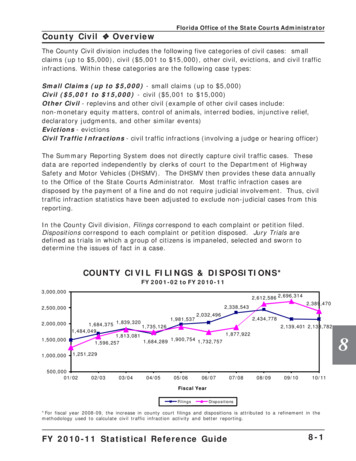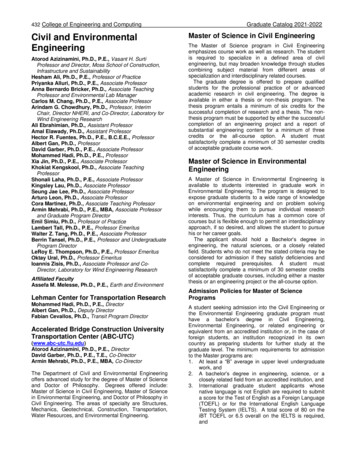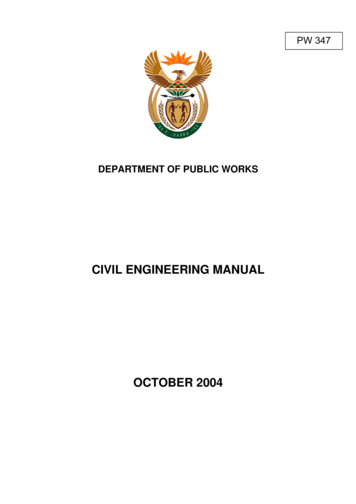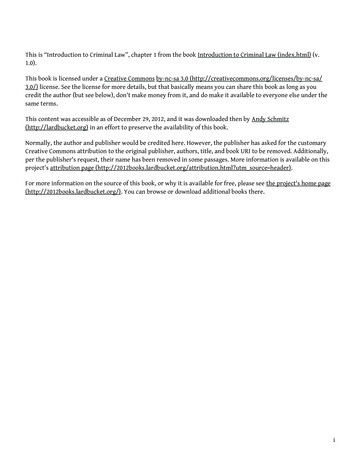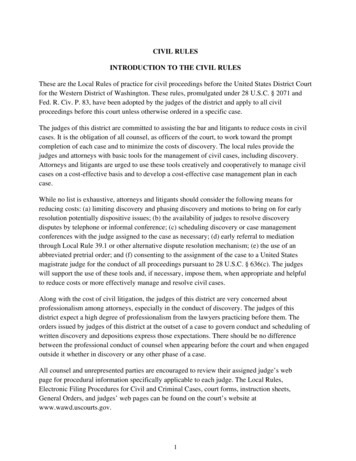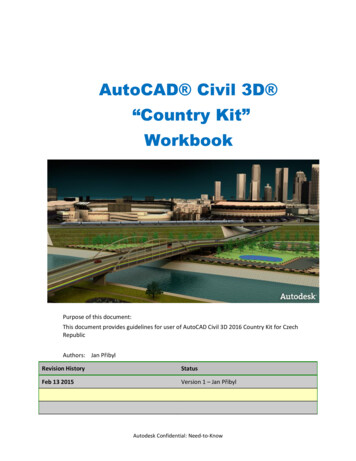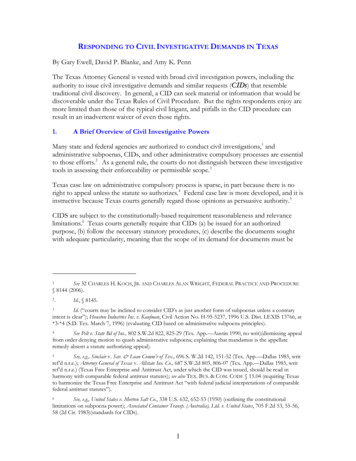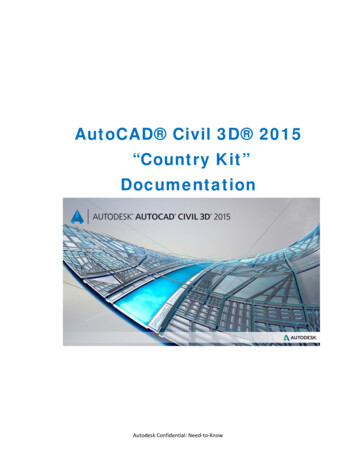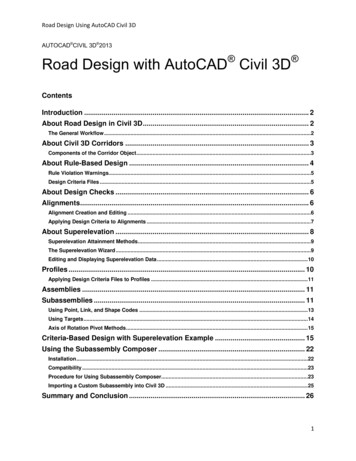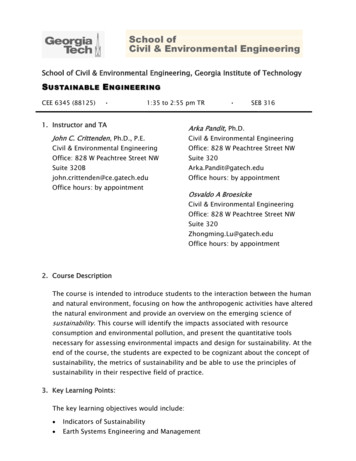
Transcription
School of Civil & Environmental Engineering, Georgia Institute of TechnologyS USTAINABLE E NGINEERINGCEE 6345 (88125) 1:35 to 2:55 pm TR1. Instructor and TA SEB 316Arka Pandit, Ph.D.John C. Crittenden, Ph.D., P.E.Civil & Environmental EngineeringCivil & Environmental EngineeringOffice: 828 W Peachtree Street NWOffice: 828 W Peachtree Street NWSuite 320Suite h.eduOffice hours: by appointmentOffice hours: by appointmentOsvaldo A BroesickeCivil & Environmental EngineeringOffice: 828 W Peachtree Street NWSuite 320Zhongming.Lu@gatech.eduOffice hours: by appointment2. Course DescriptionThe course is intended to introduce students to the interaction between the humanand natural environment, focusing on how the anthropogenic activities have alteredthe natural environment and provide an overview on the emerging science ofsustainability. This course will identify the impacts associated with resourceconsumption and environmental pollution, and present the quantitative toolsnecessary for assessing environmental impacts and design for sustainability. At theend of the course, the students are expected to be cognizant about the concept ofsustainability, the metrics of sustainability and be able to use the principles ofsustainability in their respective field of practice.3. Key Learning Points:The key learning objectives would include: Indicators of Sustainability Earth Systems Engineering and Management
Integration of the Environmental, Social and Economic Issues Life Cycle Analysis oLife Cycle InventoryoRisk and Impact AssessmentMaterial Flow AnalysisoUrban Metabolism Target Plots Industrial Ecology Urban Sustainability Dynamics of sustainability in the Developed and Developing world Agent-based Modeling Geoengineering Business Models of SustainabilityEngineering Working Definition of Sustainable Development:Our socioeconomic system is far from sustainable and this may cause us guilt and perhapsfrustration and so there may be a tendency to just give up. Consequently, we will use thisdefinition for this class.Roy F. Weston: “Sustainable Development is a process of change in which thedirection of investment, the orientation of technology, the allocation of resources,and the development and functioning of institutions that meet present needs andaspirations without endangering the capacity of natural systems to absorb theeffects of human activities, and without compromising the ability of futuregenerations to meet their own needs and aspirations.”A simpler working definition of sustainable engineering can be as follows:Sustainable Engineering is the design of human and industrial systems to ensurethat humankind’s use of natural resources and cycles do not lead to diminishedquality of life due either to losses in future economic opportunities or to adverseimpacts on social conditions, human health and the environment.These requirements reflect that social conditions, economic opportunity, andenvironmental quality are essential if we are to reconcile society’s development goals withinternational environmental limitations.
4. Class OperationThis course involves active learning on the part of the students. The class will be broken upinto groups. Each group will work together on homework and final project.Prerequisites:This course is meant to be taken by both engineering and non-engineering students. Itrequires basic mathematical skills, and the willingness to conduct quantitative analyses.Especially for the group project, students with different backgrounds may be called uponto contribute in different ways.Attendance:Students should sign in at the beginning of each class. A sign-in sheet will be provided bythe instructor.Grading:Homework and Class Participation25%Mid-Term Exam25%Journal Article Critique10%Class Project40%Homework:Homework is to be done individually but you certainly can seek advice from your group andothers.Homework Assignments Format:1.Unless the problems are very short, begin each problem on a new sheet.2.Always restate the problem indicating the given information, desiredinformation and explain your method. Make liberal use of comments.3.Make liberal use of sketches.4.Always use units in your calculations and on graphs. For quantitativeproblems please underline the final answers.5.Above all, BE EXTREMELY NEAT.
Class Project:Class Projects are to be worked on as a group. They represent a group effort and eachgroup will write a group report. Sustainable solutions will require coordinated collectiveefforts with stakeholders with diverse opinions and objectives. The group projects shouldbe considered an opportunity to explore this approach.The report should not be unnecessarily long, but should contain the following elements:Abstract. Most technical journals require abstracts which summarize the content of a paperin one or two paragraphs. The abstracts may be written in the form used in the scientificJournals. Please include concluding remarks in the abstract. Every statement in theconclusion should be capable of undergoing careful scrutiny.Introduction. The introduction should provide the reader with a concise statement of thetheoretical and rational basis. It would be appropriate to follow the form frequently usedin the scientific Journals for the introduction and succeeding sections.Approach. The approach that was used to gather, analyze and synthesize a solution to theissue should be discussed in this section. If this section is written correctly, the results anddiscussion section will be more concise and will focus only on the presentation of theresults and interpret the results.Results and Discussion. Results should be summarized, tabulated, or plotted neatly.Particular attention should be paid to the units employed. S.I. units are preferred. Samplecalculations should be shown. This section of the report gives greatest insight into theintegrity of the writers. It is very easy to over interpret results. Caution should beobserved in interpreting the results and alternatives should be considered.Future Research and/or Investigation. Most good investigations raise additional questionsthat can not be addressed without additional time, talent and resources. The sectionshould help focus the reader on what should be undertaken next.References Cited. Please refer to the American Chemical Society guideline for the formatthat should be used and the manner in which references are /1246030496632/chapter14.pdf).10 to 15 pages of text, excluding references, tables and figures, is a good target for thepaper. I expect you to use the basic principles that we discuss in class: 12 greenengineering principles in your recommendations, LCA, material flow analysis. Also, Iexpect you to examine sustainability metrics.
5. Course ContentWeekDateContentRecommended Readings (readings would be posted on T-Square) McIsaac, G.F., Morey, N.C. Engineers’ role in sustainable development:Considering cultural dynamics, Journal of Professional Issues inEngineering Education and Practice 1998, 124 (4), 110-119 Crittenden. J.C. Engineering the quality of life. Clean Techn. Environ. Policy23-AugClass Introduction / Sustainability and SustainableEngineering12002, 4, 6-7. Mihelcic, J.R., et al. Sustainability science and engineering: The emergenceof a new metadiscipline. Environ. Sci. Technol. 2003, 37 (23), 5314-5324. Sustainability and Engineering in New Zealand: Practical Guidelines forEngineers. Xu, M; Crittenden, C; et al. Gigaton Problems Need Gigaton Solutions,Environ. Sci. Technol. 2010, 44 (11), 4037-4041. Chow, J., Kopp, R.J., Portney, P.R. Energy resources and global25-Aug Energy and Climate Changedevelopment. Science 2003, 302, 1528-1531. Pacala, S., Socolow, R. Stabilization wedges: Solving the climate problemfor the next 50 years with current technologies. Science 2004, 305, 968972. Washington, W.M., et al. How much climate change can be avoided bymitigation? Geophys. Res. Lett. 2009, 36, L08703.30-Aug Energy and Climate Change: Continued Fargione, et al., Land Clearing and the Biofuel Carbon Debt, Science 2008,319, 1235-1238. Myhrvold, N.P., Caldeira, K., 2012. Greenhouse gases, climate change andthe transition from coal to low-carbon electricity. Environ. Res. Let, 7,2014019 Wigley, T. M. L., A Combined Mitigation/Geoengineering Approach toClimate Stabilization. Science 2006, 314, 452-4541-Sep Geoengineering: Carbon Cycle Victor, D. G., et al., The Geoengineering Option. Foreign Affairs, 2009,88(2), 64-76 Stavins, R. N; The Costs of Carbon Sequestration: A Revealed-PreferenceApproach. The American Economic Review, 1999, 89 (4), 994-1009
WeekDateContentRecommended Readings (readings would be posted on T-Square) Kauppi, P; Sedjo, R; Technological and Economic Potential of Options toEnhance, Maintain, and Manage Biological Carbon Reservoirs and Geoengineering, Chapter 4, Climate Change 2001: Mitigation, IPCC Third36-Sep Geoengineering: Other Natural CyclesAssessment Report, 2001, 301-344 Rockström, J., et al., 2009. A safe operating space for humanity. Nature461, 472–475 Barnosky, A.D., et al., 2012. Approaching a state shift in Earth’sbiosphere. Nature 486, 52–58 Matthews, E., et al. The Weight of Nations: Material Outflows fromIndustrial Economies; World Resource Institute: Washington DC, 2000. Bringezu, S., et al. International comparison of resource use and itsrelation to economic growth: The development of total material8-Sep Material Flow Analysisrequirement, direct material inputs and hidden flows and the structure ofTMR. Ecol. Econ. 2004, 51, 97-124. Gerst, M. D; Graedel, T. E; In-Use Stocks of Metals: Status andImplications. Environ. Sci. Technol. 2008, 42 (19), 7038-7045. ISO. Environmental Management: Life Cycle Assessment, Principles andFramework; ANSI/ISO 14040, 1997.8-Sep Life Cycle Assessment Hendrickson, C., Horvath, A. Economic input-output models forenvironmental life-cycle assessment. Environ. Sci. Technol. 1998, 32 (7),184A-191A. Williams, E.D., Ayers, R.U., Heller, M. The 1.7 kilogram microchip: Energy4and material use in the production of semiconductor devices. Environ. Sci.Technol. 2002, 36 (24), 5504-5510.13-Sep Life Cycle Assessment: Continued Hauschild, M.Z. Assessing environmental impacts in a life-cycleperspective. Environ. Sci. Technol. 2005, 39 (4), 81A-88A. Scientific Applications International Corporation (SAIC). Life CycleAssessment: Principles and Practice; US EPA: Cincinnati, Ohio, 2006. Carnegie Mellon University Green Design Institute. Economic Input-Output515-Sep LCA Example on Water Treatment TechnologiesLife Cycle Assessment (EIO-LCA) Model; http://www.eiolca.net/. National Renewable Energy Laboratory (NREL). U.S. Life-Cycle InventoryDatabase; http://www.nrel.gov/lci/. Duchin, F. Industrial input-output analysis: Implications for industrialecology. PNAS 1992, 89, 851-855.
WeekDateContentRecommended Readings (readings would be posted on T-Square) Lave, L.B., et al. Using input-output analysis to estimate economy-widedischarges. Environ. Sci. Technol. 1995, 29 (9), 420A-426A. Hendrickson, C.T.; Lave, L.B.; Matthews, H.S. Environmental Life CycleAssessment for Goods and Services, Chapter 2: Hybrid LCA Analysis;Resources for the Future Press: Washington DC, 2006.20-Sep Preliminary Group Project Presentation 22-Sep Grand Challenges for SustainabilitySteffen, W., et al. Global Change and the Earth System: A Planet underPressure, Executive Summary; Springer: Heidelberg, 2004. Costanza, R., et al. Sustainability or collapse: What can we learn fromintegrating the history of humans and the rest of nature? Ambio 2007, 36(7), 522-527. 6Liu, J., et al. Complexity of coupled human and natural systems. Science2007, 317, 1513-1516.27-Sep Grand Challenges continued: Technology Solutions Kolpin, D. W., et al. Pharmaceuticals, hormones, and other organicwastewater contaminants in U.S. streams, 1999-2000: A nationalreconnaissance. Environ. Sci. Technol. 2002, 36 (6): 1201-1211. Allenby, B. The industrial ecology of emerging technologies. J. Ind. Ecol.2009, 13 (2), 168-183.Risk Assessment: Target Plots, Pollution Prevention729-Sep Assessment Framework, QSAR Model, Relative Risk US EPA. Pollution Prevention (P2) Framework; 2005Indices Cash, G.G. Prediction of chemical toxicity to aquatic organisms: ECOSARvs. Microtox Assay. Environ. Toxicol. Water Qual. 1998, 13 (3), 211-216.Risk Assessment: Comparison of Two Industry4-OctSectors, Reaction Pathway Selection Anastas, P.T., Zimmerman, J.B. Design through the 12 principles of green8engineering. Environ. Sci. Technol. 2003, 37 (5), 94A-101A.Tools for Sustainable Engineering: 12 Principles for McDonough, W., et al., Applying the principles of green engineering to6-Octcradle-to-cradle design. Environ. Sci. Technol. 2003, 37 (23), 434A-441A.Sustainable or Green Engineering The President’s Council on Sustainable Development. Towards aSustainable America; 1999.11-Oct No Class. Student Recess913-Oct Mid-term Examination
WeekDateContentRecommended Readings (readings would be posted on T-Square) Grimm, N.B., et al. Global change and the ecology of cities. Science 2008,18-Oct Urban Sustainability: Introduction319, 756-760. Batty, M. The size, scale, and shape of cities. Science 2008, 319, 769-771.Urban Sustainability: Urban Development20-OctSimulations, Air Quality and Heat Island Li, K., et al. Development of a framework for quantifying theenvironmental impacts of urban development and construction practices.Simulations, Cyberinfrastructure for UrbanEnviron. Sci. Technol. 2007, 41 (14), 5130-5136.Sustainability10 Bonabeau, E., Agent-based modeling: Methods and techniques forsimulating human systems. PNAS. 2002. 9, 7280-728725-Oct Agent Based Modeling Macy, M. W; Willer, R; From Factors to Actors: Computational Sociologyand Agent-Based Modeling. Annual Review of Sociology. 2002, 28, 14316627-Oct Interim Group Project Presentation11 UN, The Millennium Development Goals Report, New York, 20051-Nov Global Perspectives Rees, W. E; The built environment and the ecosphere: a global perspective,Building Research & Information, 1999, 27(4/5), 206–2203-Nov Introduction to Industrial Ecology13Metrics of Industrial Ecology: Thermodynamic8-Nov Metrics and Environmental Metrics (Global WarmingPotential)10-NovMetrics of Industrial Ecology: Other Environmental Jelinski, L.W., et al. Industrial ecology: Concepts and approaches. PNAS1992, 89, 793-797. Frosch, R.A. Industrial ecology: A philosophical introduction. PNAS 1992,89, 800-803. von Hauff, M., Wilderer, P.A. Industrial ecology: Engineered representationof sustainability. Sustain. Sci. 2008, 3, 103-115.Metrics Rees, W., Ecological footprints and appropriated carrying capacity: Whaturban economics leaves out. Environment and Urbanization. 1992, 4(2),14121–130.Sustainability Metrics: Ecological Footprint,15-Nov Genuine Progress Indicator, EnvironmentalSustainability Index Anielski, M; Rowe, J., The Genuine Progress Indicator – 1998 Update.1999. Redefining Progress Esty, Daniel C., Levy, M; Srebotnjak, T; de Sherbinin, A., 2005Environmental Sustainability Index: Benchmarking National EnvironmentalStewardship. 2005 New Haven: Yale Center for Environmental Law &Policy.
WeekDateContentRecommended Readings (readings would be posted on T-Square) Costanza, R; Daly, H. E., Toward an ecological economics. EcologicalModelling. 1987, 38 (1-2), 1-7.17-NovEconomic and Societal Sustainability: Ecological Costanza, R; et al; The value of the world's ecosystem services and naturalcapital, Nature 1997, 387, 253-260Economics Costanza, R; et al., Managing Our Environmental Portfolio. BioScience.2000, 50(2), 149-155. Viljoen, J; Defining a business model for sustainability – does one size fitall? 2008. World Export Development Forum15 Nidumolu, R; Prahalad, C. K., Rangaswami, M. R; Why Sustainability Is Nowthe Key Driver of Innovation, Harvard Business Review, 2009.22-NovLegal and Political Realm of Sustainability, Business Papadakis, K; Socially sustainable development and participatorygovernance: legal and political aspects, 2006, International Institute forModels for Sustainability, Role of EngineersLabour Studies Geneva Magretta, J; Growth through global sustainability. 1997, Harvard BusinessReview, 79-88 Hart, S. L; Milstein, M. B; Global Sustainability and the Creative Destructionof Industries, Sloan Management Review, 1999 (Fall), 23-33161724-Nov No Class. Thanksgiving Holiday29-Nov Final Group Project Presentation1-Dec Final Group Project Presentation6-Dec No Class. Prepare for Project Report
6. Useful LinksUN tp://www.unep.org/(UN Division of Sustainable Development)(UN Environment US EPA)http://www.iisd.org/measure/(International Institute for Sustainable Development)http://themes.eea.eu.int/all indicators box(European Union)http://themes.eea.eu.int/index html#Sectors and activities(European s/index.htm(United )http://www.worldbank.org/data/wdi2001/(World Development adleycentre/(Climate Prediction & ction.org/(Constructing Excellence)http://www.cbpp.org.uk/(Best Practices)http:www.m4i.org.uk(Movement for te:http://www.epa.gov/osw/(US EPA)http://ewasteguide.info/(Electronic t.asp(Energy Business Intelligence)http://www.eren.doe.gov/(Renewable Energy)http://www.cee1.org/home.html(Consortium of Energy Efficiency)
LCA:http://iac.rutgers.edu/database/(14,000 Assessment)http://hpb-1a.nrel.gov/lci/(US LCI database)http://www.epa.gov/nrmrl/lcaccess/(US EPA)http://www.life-cycle.org/(LCA Links)http://www.eiolca.net/(CMU EIOLCA)Listing of World Wide Environmental Agencies / tm(Listing of Agencies)http://gemi.org/(Global Environnemental Management tainable Business)http://www.wbcsd.org/(World Business Council on Sustainable Development)http://www.ceres.org/(Coalition for Environmentally Responsible Economies)http://www.globalreporting.org/(Global Reporting Initiative)http://www.ulsf.org/(University Leaders for a Sustainable Future)http://www.sdcn.org/(Sustainable Development Communications o/(Environment Portal & Search Engine)http://www.secondnature.org/(Second Nature – Sustainable nable Living Network)http://www.ucsusa.org/(Union of Concerned g/(The Green Engineering Program)http://www.epa.gov/dfe/(Designing for Environment Program)http://www.epa.gov/cpg/(Comprehensive Procurement Guidelines Program)http://www.epa.gov/sectors/(The Industry Partners p2framework/(The P2 epr/(The Product Stewardship Program)
Sustainability-related l/118902538/home(Journal of Industrial mental Science & Journal of Cleaner (Ecological ergy)http://www.elsevier.com/locate/enpol(Energy nal of Environmental 370(Environmental 154(Sustainability esources, Conservation and /(International Journal of Life Cycle Assessment)
School of Civil & Environmental Engineering, Georgia Institute of Technology SUSTAINABLE ENGINEERING CEE 6345 (88125) 1:35 to 2:55 pm TR SEB 316 . the natural environment and provide an overview on the emerging science of . Tools for Sustainable Engineering: 12 Principles for Sustainable or Green Engineering cradle Anastas, P.T .

